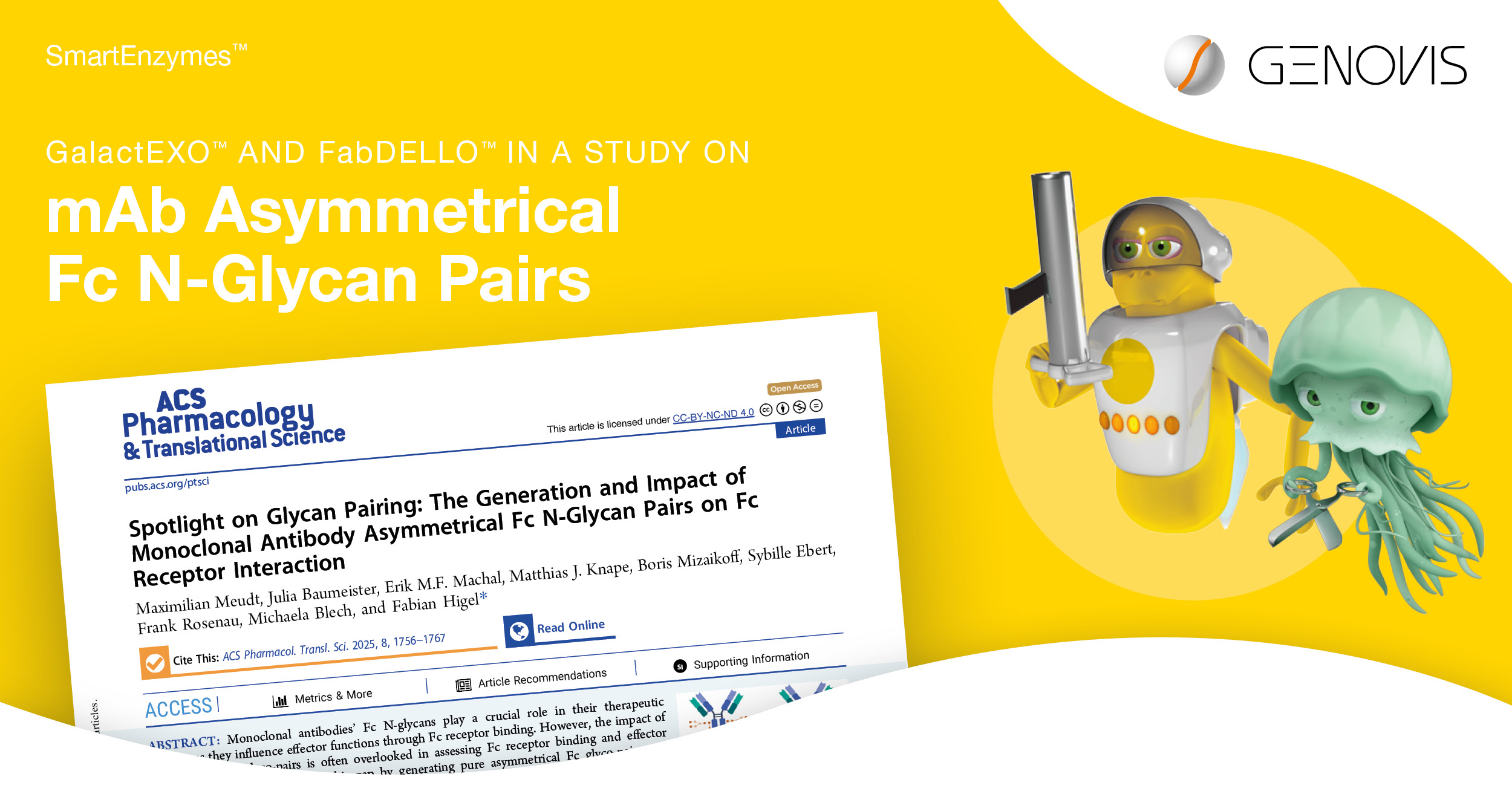
Understanding the Functional Impact of Monoclonal Antibody Asymmetrical Fc N-Glycan Pairs using SmartEnzymes™
Scientists at Boehringer Ingelheim and collaborators have developed a novel method to generate antibodies with defined asymmetrical Fc glycoforms and evaluate their Fc receptor (FcγRs) binding properties. Combining enzymatic digestion and redox-mediated Fc recombination, Fc fragments with specific glycan pairings could be generated and their Fc receptor binding analyzed by surface plasmon resonance (SPR) spectroscopy.
GalactEXO™, a β-Galactosidase mix that hydrolyses β1-3,4-linked terminal galactose on N-glycosylated proteins, was used for controlled hypogalactosylation of Fc N-glycans. Additionally, FabDELLO™, a protease that digests human IgG1 at a single site above the hinge, allowed generation and isolation of the Fc fragment for analysis. Once symmetrical glycoforms were created, disulfide bonds were reduced, and recombination under oxidizing conditions generated Fc heterodimers with defined asymmetry. These fragments were then characterized by mass spectrometry and tested for binding to various FcγRs using SPR.

Figure 1. GalactEXO is a β-Galactosidase mix that hydrolyses β1-3,4-linked terminal galactose on N- and O-glycosylated proteins or oligosaccharides. FabDELLO is a protease that digests human IgG1 at a single site above the hinge, yielding intact Fab and Fc fragments within two hours, with no need for reducing conditions.
Monoclonal antibodies (mAbs) are widely used in therapeutic and research settings, and their function is heavily influenced by glycosylation. In particular, the Fc region of IgG contains two N-linked glycan chains that modulate interactions with FcγRs, which in turn affect immune functions like antibody-dependent cellular cytotoxicity (ADCC). Traditional studies have focused on symmetrical glycosylation, where both Fc chains hold identical glycans, but in reality, most circulating antibodies exhibit asymmetrical glycan pairing. In this study, the authors sought to understand the biological consequences of this natural asymmetry which, up until now, has been unclear.
The study found that asymmetrical Fc glycan pairing measurably affects binding to all FcγRs. Isolation of the Fc fragments following FabDELLO digestion sought to minimize potential variability due to interferences with light chain assembly after redox treatment and ensured that the intended Fc effector functionality analysis was based solely on Fc properties. SPR analysis demonstrated that afucosylation strongly enhanced FcγRIIIa binding, and that a single afucosylated glycan on one Fc chain (e.g. in a G0F:G0 pair) is sufficient to significantly increase receptor affinity. Interestingly, full afucosylation to a G0:G0 pair did not result in substantial further changes in affinity.
Similarly, and although galactosylation had a smaller overall effect on FcγRIIIa binding than afucosylation, hemi-galactosylation of a glyco-pair was sufficient to account for any observed effect. GalactEXO proved to be an effective tool in the modulation of terminal galactosylation of the Fc glycans allowing for the overall impact of galactosylation to be determined. Galactosylated glycans showed increased binding to FcγRIIa compared to their agalactosylated counterparts, and this effect was evident even when only one Fc chain carried galactose. While binding to FcγRIIa was shown to be primarily driven by levels of galactosylation, it could also be established that complex stability of the Fc with FcγRIIb was primarily driven by afucosylation.
The authors of this study have introduced an elegant biochemical platform incorporating GalactEXO and FabDELLO to manipulate and study Fc glycan asymmetry. The work described here highlights the functional importance of evaluating mAb Fc glycosylation at the paired-chain level, rather than assuming bulk glycoform effects. The ability to resolve differences between symmetrical and asymmetrical glyco-pairs allows novel insights into the binding mechanisms. This approach supports in-depth investigation of how subtle structural differences in antibody glycosylation translate into functional effects. This understanding may pave the way for the design of more effective and tailored antibody therapies; however, the implications of the reported complex stability differences in vivo require further investigation.
Reference
Meudt et al., 2025. Spotlight on Glycan Pairing: The Generation and Impact of Monoclonal Antibody Asymmetrical Fc N‑Glycan Pairs on Fc Receptor Interaction. ACS Pharmacol. Transl. Sci.
GalactEXO™ – Hydrolysis of β1-3,4 galactose
FabDELLO™ – Above hinge digestion of human IgG1


